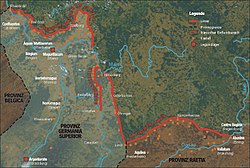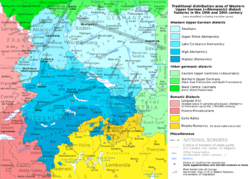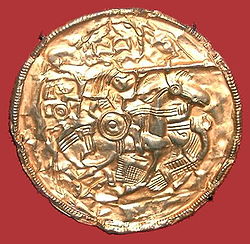Alamanni
The Alamanni, Allemanni, or Alemanni were a group of west Germanic peoples. They lived around the upper Main, which is the longest tributary of the Rhine. They expanded their territory around parts of Germania and present-day Alsace. The land they lived on was called Alemannia.[1]
Other use
Alamanni Media
Alamannia is shown beyond Silva Marciana (the Black Forest) in the Tabula Peutingeriana. Suevia is indicated separately, further downstream of the Rhine, beyond Silva Vosagus.
Alemannic belt mountings, from a seventh-century grave in the grave field at Weingarten
The Limes Germanicus 83 to 260 CE.
The gold bracteate of Pliezhausen (sixth or seventh century) shows typical iconography of the pagan period. The bracteate depicts the "horse-stabber underhoof" scene, a supine warrior stabbing a horse while it runs over him. The scene is adapted from Roman era gravestones of the region.
The seventh-century Gutenstein scabbard, found near Sigmaringen, Baden-Württemberg, is a late testimony of pagan ritual in Alemannia, showing a warrior in ritual wolf costume, holding a ring-spatha.
References
- ↑ "Cassius Dio: Roman History". University of Chicago.







